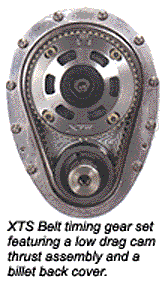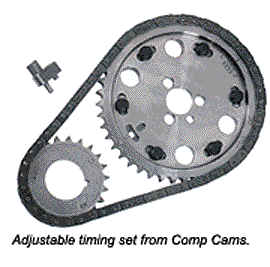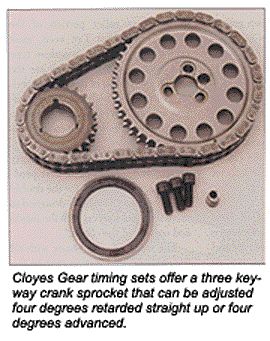The simple timing chain: it has a distinct function, yet constantly changing designs, materials, procedures and refinements make for a part that seems to evolve by the month. With such changes going on, how do we know what chain and gears are the best to use on a particular engine?
When the automobile was invented, the timing design was easy: the simpler the car, the simpler the engine. According to Steve Markley of Egge Machine (a company that knows a thing or two about old cars), “The early cars were mostly in-line engines, so they used gear-to-gear timing setups. As the vehicles got more complicated, exotic and expensive, engineers started using chains and sprockets to time the engines and run accessories (pumps, generators, etc)”
Since then, says Egge’s Markley, the industry has witnessed the change from chains to belts and back and forth again and the development of everything from fiber to cast iron to aluminum gears.
Where do we stand today, especially as timing relates to performance engines? We asked a number of the key players in the field to give us an update on what’s new and more importantly, how to choose it. In addition, we found how one company’s focus on one simple aspect helped out elsewhere on the vehicle. While such crossover technology is far from new, it’s amazing how one new development can play out in other areas.

CV Products is known for its hardcore racing products, says company spokesman Ryan White “Setting our standards high is the key. Our XTS system is state of the art but yet different. In fact, our claim for our Xceldyne model is that it completely eliminated the extinct drive technology developed over a decade ago!”
White says the all-new XTS Belt Drive easily bolts on with no need for block machining and provides more consistent cam timing. It has a built-in front belt guard that touches only the root of the belt and not the cord, protecting the smooth operation of the belt and eliminating a major cause of belt failure with other drives.
“Our belt drive may be similar to others,” says White, “but has been designed with advances built in. It has a billet back cover. And engine builders don’t have to worry about block machining to accommodate it. We have a thrust bearing on ours that’s different also. While some bearings have to be shimmed, ours is machined to match properly. It’s called a low drag cam thrust assembly and it’s patent pending.”
But White says the advances don’t stop there. “It’s balanced, and the three bolts that bolt into the cam are balanced. The unit spins perfectly balanced in your hand and doesn’t shake.” So what does that mean for engine builders? “The system also has a longer service life than traditional bearings without complicated oiling configurations.”
Attention to the design and surface of the gears has yielded long-term benefits, White explains. “Our crank and cam gears are hard-coated to reduce wear. The gears are also designed in conjunction with the belt used. Goodyear Super Torque belts precisely match the pulley’s tooth profile for more consistent cam timing. It will definitely reduce wear-affected degree changes.”
And that brings up a question. Just what can be done to a gear to make it more effective? SA Gear asked that and came up with better gears.
SA Gear’s Steve Tucker says, “Our high end crank sprockets are all 1144 billet steel, induction heat treated for hardness. All receive a final hone on the bore, black oxide coating and laser marking. Cam sprockets are 1144 if they are high end and 3000 grade iron for the lower end, which meets all OE hardness specs. Most cam sprockets have a press fit thrust bearing option.”
The approach to new products is simple, says Tucker. “We look at potential performance applications as they become popular and then create a performance version of the OE timing set. Typically, this involves converting the chain to double- or single-roller and the crank sprocket to three- or nine-keyway adjustability. Our newest release is a performance version for the LS1 Chevrolet engine that encompasses all of these features.”
Borg Warner developed its Hy-Vo chain primarily for transmission and drive sets for today’s most popular front-, four- and all-wheel drive drivetrains, according to company spokesperson Carol Dupke-Lee. “The Morse Hy-Vo TEC multi indexing timing system uses a transmission style chain in the high performance engine application,” she says.
The new generation multi indexing timing system was originally developed for Ford and Roush Racing on the Ford 3.8L engines, says Dupke-Lee. “This new product is more efficient for high performance timing. The chain test results on the Hy-Vo TEC system resulted in a less than one hp loss at 9,000 rpm versus the roller chain system at a 1.5 hp loss at 9,000 rpm.”
In addition to the power savings, the new system is much stronger, Dupke-Lee says. “In fatigue testing, the roller chain system was rated at 100 percent and the Hy-Vo testing rated at a yield of 178 percent. The tensile strength of the belt system was 3,000 lbs., the roller chain was 8,200 lbs., and the Hy-Vo went up to 14,900 lbs. “That’s a substantial difference.”
Selection
When it comes to choosing the right timing set, Ken Sink of Milodon recommends engine builders first understand the differences in roller timing chains. “There are several different styles. Ours have a .250? diameter solid, non-split design, and are seamless. Others are split, flat metal and rolled.” From his perspective, says Sink, not understanding the differences in design and manufacturing or how they apply to engine performance is when engine builders start having problems.
Backing away from the product to take a better look at the manufacturer itself is suggested by Walter Gonzales of Safety Auto Parts Corp, “An engine builder should really look at any company he does business with,” says Gonzales. “He needs to know if the company uses new steel as opposed to recycled metal. And find out your supplier’s policy on heat treating – heat treating is a major issue.”
Gonzales cites the industry buzzword of “interference” as today’s divider of parts character. It means when a part destructs and takes the majority of the engine with it. In the past, chains and gears could fail without catastrophic results to the engine. But today, with tolerances and clearances taken literally to the max, a simple timing chain failure often destroys the entire engine.
Part of the safety is in proper sizing, says Gonzales. “What’s really important is equal lengths. Each link has to be precisely matched to the others.”
Gonzales says he sees more change on the horizon, but cautions that change isn’t necessarily always for the best. “I know they are changing some chain systems to belts and some belts to chains,” he says. “But steel is always going be stronger than rubber.”

Chris Mays of Comp Cams says selection should be based upon an engine builder’s personal preference and knowledge. “As suppliers, we will back up his need for horsepower with the proper products. If I’ve got a guy with a 700 hp engine, I’m moving him all the way up to a billet drive. The opposite is a guy with a 350 hp engine in a street rod that won’t always need a billet set.”
Mays says the advantages offered by Comp’s Hi-Tech are, “the pre-stretched chain, heavy-duty large pin design and the gear set is also dynamically balanced and checked for run-out tolerances.”
Mays says, “There is, of course, a high-end version. The best of our best is going to be a billet gear set with hard steel billet top and bottom gear, a nine-way key sprocket, and the same pre-stretched chain and large pin design. This chain and gear set also includes a Torrington roller thrust bearing for reduced friction.”
Cloyes Gear & Products’ Adam Reed says, “For product identification, the main need is a true evaluation of the engine as far as the rpm and the true horsepower. Then you start looking at whether you are going to degree the cam. We offer sets that are infinitely adjustable for fine-tuning. If accuracy is not that important, a three-keyway crank sprocket is available that can be adjusted four degrees retarded, straight up or four degrees advanced. Our Hex-A-Just system can be adjusted six degrees retarded or advanced, or hit all points in between.”

The new Cloyes LS2 timing set has a sensor shroud with a bolt-in timing set. It has a billet sprocket and needs no additional mods to the block. It, too, is available in the Hex-A-Just model, says Reed, “so you can dial in your timing.”
But satisfaction isn’t always just about exotic high-end parts. Sometimes simple specialization will service a market. The people at Elgin know that, “Our Pro-Stock brand is good for the street racer and the Saturday night circle tracker,” Rick Simko says.
“We offer a true roller where the bushing on the chain rolls in and out on the teeth of the sprocket. It adds a little bit of extra horsepower, about 10 hp or so. We also go up to a nine keyways which is four timing marks on either side,” explains Simko.
So while the Elgin Pro-Stock brand adds some power, they also offer adjustability for the builder working within those niche markets. “When it comes to costs versus more exotic parts, the builder has to choose.” Simko says, “To be quite honest with you, his next concern is how much money is in the motor. The everyday guy has only so much to spend.”
When the market turns to older-style engines, one might think that all of today’s advancements should easily apply to the restoration market. Not necessarily, warns Egge’s Markley. “For a lot of the older engines, there’s no practical way to apply today’s timing component technology. People tend to think that, just because they’re antique cars these engines were built like Swiss timepieces.
The problem antique engine builders often face is finding appropriate timing components that DO work with their particular engine. In many cases, because of the declining vehicle population, suppliers simply stop producing the parts.
Availability is always a factor for older engines in both original and high-performance parts Markley says, “Sometimes, the determining criteria isn’t ‘what do I want,’ but ‘what can I get?’ For older engines, there just isn’t a lot to choose from in the way of performance products.”
Progear/Avon’s Art Tinaglia says, “Your basics on selecting a timing chain set are fit, quality of materials and durability, and quality of workmanship. These are often overlooked.”
Tinaglia explains, “There may be an incident when a timing chain breaks. Vehicle owners (and engine builders) often jump to the conclusion that the chain is bad. A lot of times the chain is a victim, not the cause. One of the things people need to look for is good eccentricity. From your bearing surfaces, on your sprocket, be it bore or counter bore, to where the teeth and chain make contact with them. You need to have that bore or counter bore concentric to the points on the teeth. If it’s a roller chain sprocket it should be even from the bore or counter bore to the root diameter of the sprocket. If it’s not, you’ve got this thing bobbing up and down five or six-thousandths out of round. That’s not good and will beat the chain up. Then the chain breaks and customer says the chain is bad.”
Tinaglia says the best thing a builder can do is check the concentricity with the proper tools, not just by “eyeball gauge.”
“Use instruments,” he says. “That means somebody took the time to check this thing as they built it.”
Tinaglia goes on to cite other problems that can be identified by inspection “What often fails on a roller chain is the independent roller, or you’ll find poorly made pins wearing two, three or four thousandths – enough to look like what the customer will call chain stretch. Our pins are chromized, the tech term we use to describe infusing chromium into the surface structure of the pins. Our rollers are seamless and precision cold formed then shot-peened and polished and then finally the ID of the roller is burnished.”
Checking out the main components, including the construction of the sprocket, is another way to see quality, says Tinaglia. “If you’ve got a heat-treated product, it’s a better product. The cam gears are heat treated in our Progear 3K and 4K series. Deburring is also important. We hand file all of our gears, then they are vibratory tumbled. The crank sprockets are tumbled again after heat-treating by induction hardening. We hand paint each one of the markings white so the user can see what he’s got.”
Ron McKey, from the Engine Pro/Engine Parts Group says, “The key to our line is that we have a complete range for someone who wants to improve over the stock piece all the way up to our premium billet line.” McKey says his group’s variety helps ensure engine builders reach many different customers. “We have a true roller street/strip set that is available in undersize versions that can compensate for align bored blocks. They come in five and ten thousandths sizes. We have a new two-piece upper cam gear that allows the cam gear to be infinitely adjusted plus or minus 6°. That’s done using six ARP bolts that tighten down once the cam is degreed and hold it in position.”
McKey says, “Part of the criteria to selecting the product is recognizing how radical the cam is and how much valve spring pressure the engine will have and how many rpms the engine will turn. Of course, price is a factor and that’s why we have such a wide range of products.”
Melling Engine Parts’ Dan Bass says “Most of the high performance units get away from the silent type and go with a roller design. You can go with two designs. The Standard design means the roller does not roll on the chain and is pressed in place on the pin. The British design works with the roller portion of the chain actually rotating on its axis on the chain.
From there, you can get a seamed or seamless roller portion of the chain. From what I’ve seen, most builders go with the seamless type and most people think they are the most rugged. Most of the more expensive timing sets will include a seamless set up. You’re probably going to get more even roller-to-sprocket contact with a roller.”
Bass says the future designs may be like his company’s newest product. “Our new product for the double overhead cam Chrysler is designed to drive the sprockets on both the inside and outside of the chain.”
The simple timing chain; with all the changes, its function may be the only thing that stays the same.
For more manufacturers and distributors of timing sets, visit the Engine Builders Buyers Guide on our Web site at www.engine-builder.com













